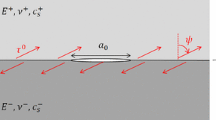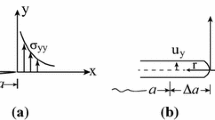Abstract
A numerical method is presented for obtaining the values of K* 1,K * II and K* III in the elasticity solution at the tip of an interface crack in general states of stress. The basis of the method is an evaluation of theJ-integral by the virtual crack extension method. Individual stress intensities can then be obtained from further calculations ofJ perturbed by small increments of the stress intensity factors. The calculations are carried out by the finite element method but minimal extra computations are required compared to those for the boundary value problem. Very accurate results are presented for a crack in the bimaterial interface and compared with other methods of evaluating the stress intensity factors. In particular, a comparison is made with stress intensity factors obtained by computingJ by the virtual crack extension method but separating the modes by using the ratio of displacements on the crack surface. Both techniques work well with fine finite element meshes but the results suggest that the method that relies entirely on J-integral evaluations can be used to give reliable results for coarse meshes.
Résumé
On présente une méthode numérique en vue d'obtenir les valeurs de K* 1, K* II et K* III relatives à la solution élastique d'application à l'extrémité d'une fissure d'interface sujette à un état de contraintes général. La méthode repose sur l'évaluation de l'intégraleJ par la technique d'extension virtuelle de la fissure. On peut ensuite obtenir les intensités de contraintes individuelles à partir de calculs deJ subséquents, correspondant à des perturbations introduites par de petits accroissements des facteurs d'intensité de contraintes.
Les calculs sont accomplis par la méthode des éléments finis, mais, par rapport aux calculs à mettre en oeuvre dans le problème des valeurs aux limites, il ne faut procéder qu'à quelques calculs supplémentaires.
On présente des résultats très précis pour le cas d'une fissure dans un interface entre deux matériaux, et on les compare avec ceux provenant d'autres méthodes d'évaluation des facteurs d'intensité de contraintes.
En particulier, on fait une comparaison pour des facteurs d'intensité de contraintes obtenus en calculant J par la méthode d'extension virtuelle d'une fissure, mais en séparant les modes selon le rapport des déplacements de la surface de la fissure.
Les deux techniques fonctionnent de manière satisfaisante avec des maillages fins d'éléments finis; cependant, les résultats suggèrent que la méthode qui repose entièrement sur les évaluations de l'intégraleJ peut être utilisée afin d'obtenir des résultats fiables dans les réseaux à mailles grossières.
Similar content being viewed by others
References
M.F. Kanninen and C.H. Popelar,Advanced Fracture Mechanics, Oxford University Press, New York (1985).
J.R. Rice and G.C. Sih,Journal of Applied Mechanics 32 (1965) 418–423.
F. Erdogan,Journal of Applied Mechanics 30 (1963) 232–236, andibid 32 (1965) 403–410.
A.H. England,Journal of Applied Mechanics 32 (1965) 400–402.
J.R. Rice,Journal of Applied Mechanics 35 (1968) 379–386.
J.R. Willis,Journal of the Mechanics and Physics of Solids 19 (1971) 353–368.
R.H. Gallagher, inNumerical Methods in Fracture Mechanics, Proceedings of the First International Conference, Swansea (1978) 1–25.
D.M. Parks,International Journal of Fracture 10 (1974) 487–502.
H. Ishikawa, H. Kitigawa and H. Okamura, inMechanical Behavior of Materials, Proceedings of the Third International Conference held in Cambridge, England, K.J. Miller and R.F. Smith (eds.), Vol. 3, Pergamon (1979) 447–455.
H.D. Bui,Journal of Mechanics and Physics of Solids 31 (1983) 439–448.
J.F. Yau, S.S. Wang and H.T. Corten,Journal of Applied Mechanics 47 (1980) 335–341.
M. Stern, E.B. Becker, and R.S. Dunham,International Journal of Fracture 12 (1976) 359–368.
F.H.K. Chen and R.T. Shield,Zeitschrift fuer angewandte Mathematik und Physik 28 (1977) 1–22.
S.S. Wang and J.F. Yau,AIAA Journal 19 (1981) 1350–1356.
J.R. Rice, private communication, 1986.
C.F. Shih and R.J. Asaro, “Elastic-Plastic Analysis of Cracks on Bimaterial Interfaces Part I: Small Scale Yielding”, Report (1987).
J.R. Rice,Journal of Applied Mechanics 55 (1988) 98–103.
H.D. Hibbitt, B. Karlsson and E.P. Sorensen,User's Manual, Hibbitt, Karlsson and Sorensen Inc., Providence RI (1984).
P.G. Charalambides, J. Lund, A.G. Evans and R.M. McMeeking,Journal of Applied Mechanics 56 (1989) 77–82.
P.G. Charalambides, J. Lund, A.G. Evans and R.M. McMeeking, “A Test Specimen for Determining the Fracture Resistance of Bimaterial Interfaces.”The Processing and Mechanical Properties of High Temperature/High Performance Composites. Annual Report, Department of Materials, University of California at Santa Barbara (1987).
Author information
Authors and Affiliations
Rights and permissions
About this article
Cite this article
Matos, P.P.L., McMeeking, R.M., Charalambides, P.G. et al. A method for calculating stress intensities in bimaterial fracture. Int J Fract 40, 235–254 (1989). https://doi.org/10.1007/BF00963659
Received:
Accepted:
Issue Date:
DOI: https://doi.org/10.1007/BF00963659




